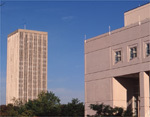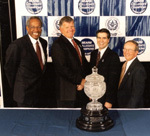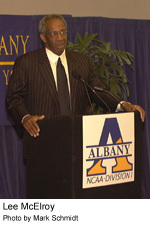

Sports
Talk
By Brian DePasquale
UAlbany Enshrines Three
Into Athletic Hall of Fame
The University at Albany will enshrine three former athletes into its
Athletic Hall of Fame on Saturday, Oct. 7, at the 17th annual HOF Brunch
and Induction Ceremony. The event will be held at 10:30 a.m. in the Recreation
and Convocation Center (RACC) Athletic Hall of Fame room on campus. Albany�s
Northeast Conference football game with St. Francis, Pa., follows at 1
p.m.
The new inductees and their sports: Jack Jordan '72, basketball; Pat Ryder '90, football; and Jeffrey York '96, track & field. With this year's class, 85 former athletes, coaches, and administrators have been inducted into the University's Hall of Fame.
Jack Jordan (1968-71) -- Among the school's all-time scorers and rebounders, Jordan was a starter on the first Albany basketball team to qualify for the NCAA Tournament.
Jordan was the sixth player in UAlbany history to score 1,000 career points. He ranks 23rd on the school's all-time scoring list with 1,011 points, 10th in career rebounding (658), ninth in career scoring average at 14.9 points per game, and fifth in career rebounding average at 9.7 per contest.
In 1968-69, Jordan averaged 12.5 points and 8.8 rebounds, as the Great Danes posted an 18-6 record and reached the NCAA College Division Tournament East Regional in Syracuse, N.Y. His teams were a combined 48-19 during his career.
As a junior, Jordan led Albany to the Capital District Tournament championship with an all-tournament performance. Jordan was a co-captain on the 1970-71 team, and the Great Danes completed the season with 10 consecutive wins to finish with a 17-5 record. During that season, he scored 22 points in an 85-70 victory over Siena. Jordan, a forward, capped his career with a 31-point outing against Ithaca. He averaged 15.8 points and 8.8 rebounds in 22 games.
A native of Green Island, N.Y. (LaSalle Institute), Jordan also played on the UAlbany freshman team in 1967-68. His 24.7 scoring average nearly broke the frosh single-season record.
Jordan, who has a B.S. in accounting, is the director of the Bureau of Compliance and Audit for the New York State Department of Health. He lives in Clifton Park, N.Y.
Pat Ryder (1986-89) -- Ryder is one of the top quarterbacks in the UAlbany football program's 28-year history.
Ryder won four varsity letters and received the team's most valuable player award on three occasions. In 1989, he became just the second player to finish the season as both the squad's top passer and rusher. He ended his career with 14 school records.
As a passer, Ryder is second on the school's all-time lists in passing yards (3,153), completions (233), and attempts (514), and is tied for second with 25 touchdown passes. He threw for 1,054 yards and 10 TDs as a junior, and recorded a career-high 191 passing yards against St. Lawrence in that same season.
Ryder, who directed a wishbone offense in the late 1980s, was the most elusive running quarterback in UAlbany annals. He is currently fourth on the all-time list with 2,245 rushing yards.
Ryder, who was team captain in 1988, was UAlbany's career scoring leader for nearly a decade until his standard was eclipsed last year. He scored 30 touchdowns and accounted for 186 points. His 30 rushing TDs is still an all-time mark.
A native of Newburgh, N.Y. (Wallkill H.S.), Ryder owns a Subway franchise in Red Hook, N.Y., and a convenience store in Newburgh. Following graduation with a B.S. in economics, Ryder played semi-professional football for four years.
Jeffrey York (1991-95) -- A five-time national hurdles champion, York is the most celebrated men's track & field athlete in University history.
As a senior, York was the 1995 NCAA Division III champion in both the indoor 55-meter hurdles and the outdoor 110-meter hurdles events. He became just the second athlete in NCAA history to win three 110-hurdles titles, and matched a record held by Otterbein College's Roger Retherford.
York, the 1994-95 University Male Athlete of the Year, captured five NCAA championships during his career, including two 55-hurdles titles (1992, 1995) and three 110-hurdles crowns (1991, 1992 and 1995). He and Frostburg State's Maynard Hurd are the only hurdlers to win five NCAA Division III championships.
In March 1995, York became UAlbany's first-ever IC4A champion, when he ran the fastest time ever by a Division III athlete in the 55-hurdles (7.23 seconds) to defeat an all-Division I field.
York is one of two hurdlers to sweep the indoor and outdoor NCAA championships in the same year twice. He added to the 55-hurdles win in 1995 with a victory in the outdoor 110-final, a event he ran in 13.85 seconds. York, who also recorded a indoor-outdoor double in 1992, and Hurd are the lone track athletes to accomplish the feat. York's efforts helped UAlbany, as a team, to its best finishes at both the men's NCAA indoor (second) and outdoor (fourth) championships.
A native of Troy, N.Y. (Troy H.S.), York continues to hold seven school records in individual and relay events. He owns the 110-hurdles mark of 13.81 seconds, and has the indoor 50-, 55- and 60-meter hurdles standards.
At age 28, York is still competitive on the national scene. He qualified for the 110-semifinals at the 2000 U.S. Olympic Trials in Sacramento, Calif. York also advanced to the 110-meter high hurdles semifinals at the 1999 USA Outdoor Track & Field championships, and was a competitor at the '95 U.S. Olympic Festival.
York, who has a B.S. in political science, is an assistant track coach on Roberto Vives' UAlbany staff. He works with the sprinters and hurdlers.
Lee McElroy�s
Vision for Change
By Bob Weiner
Lee McElroy Jr., the University at Albany�s
first-year director of athletics, is a born trouble shooter with boundless
amounts of energy but minute quantities of patience.
The 52-year-old former athletic director at American University knows how he wants to improve Albany�s relatively new Division I athletic department, and he can�t wait to pursue the challenges that await him and his staff.
The former UCLA football standout has a vision for change. Unfortunately, those modifications can�t be implemented as quickly as he would like, but he does have a comprehensive plan that fits his complex personality.
�I�m not patient, and unfortunately, that�s my major liability,� said McElroy, who also served as director of athletics at California State University-Sacramento from 1989 to 1996, leading that program in its transition from Division II to Division I and engineering a move to the Big Sky and Big West conferences. �Having an opportunity to be in our education and intercollegiate athletic system is a very special privilege. When you have that privilege, you must work with maximum effort every day. Not sometimes. I�m talking about 24 hours a day and seven days a week. I have no patience for people who see their position as just an eight-hour job.�
McElroy sees his task as a trouble shooter and a problem solver.
�It�s a calling,� he said. �I have great passion for what I do. I�ve been fortunate in that I�ve taken over some programs that have already had some success, but I came in and still remolded them. That�s my motif, and that�s what I like to do. You have to make a lot of tough decisions in my position, but I must tell you that I sleep well at night, because I know I made my decisions for the right reasons.�
The former history and government teacher remains grounded with his insights of melding academics and athletics, but many alterations must be made to continue Albany�s upgrade for its 19-sport intercollegiate athletic program. �It usually takes three to five years to make the changes we have to make,� he said. �What we�re doing now is designing and creating a new program. We have complied with all the NCAA regulations as far as becoming a Division I program, but we still have a lot of work to do.
�We have done some things operationally, like changing the ticket area and changing some access points,� said McElroy. �We have also changed how we deliver and conduct our game operations. We will continue to become more efficient and more effective.�
Since McElroy is above all a teacher, he believes that the first component in building any Division I athletic program is finding the right student-athletes. �It all starts with recruiting,� he explained. �What you will find with programs across the country is that those colleges that win consistently also perform in the classroom. They have stable classrooms and stable coaching staffs. It�s very easy to maintain that profile when you have those two components in place. But when you see programs struggle on the athletic field, they usually also struggle in the classroom. That�s when the institution struggles as well. I think it�s great that this university has a terrific academic reputation. They have selected good athletes with character. What we have to do now is to get our new people to accept that model and reinforce that with our alumni, staff, and community.�
McElroy has been carefully investigating Albany�s athletic department staff as it relates to the rest of the University. He wants to know all the facts before he makes some important changes.
�I think you have to assess the environment before you act,� he said.
�Everywhere I�ve been I�ve tried to get a sense of what the climate and environment are like. That�s the reason I�ve got the job. The next thing I�ve got to do is to see why there is success in that environment or why there is failure. Then, I enhance the successful strategies and eliminate the unsuccessful ones. You treat the staff just like a sport team, and you make sure everyone understands his or her role, and that everyone understands the plan.�
McElroy has several priorities for change.
�Clearly, our top goal is for all of our teams to get into a conference,� he said.
�Believe it or not, I work on that every day. There is not a day that goes by that I don�t think about getting into a conference.�
With only the football and soccer teams belonging to a conference, the rest of Albany�s teams are independents. Teams without conference affiliation, especially high-profile programs like the men�s and women�s basketball teams, have difficulty filling their schedules and eventually competing in postseason play.
McElroy�s other top goals are to fill numerous positions on his staff and to build a stronger relationship between UAlbany and its community. �I�ve got to hire people who believe in the balance of academics and athletics,� he said. �They must be good recruiters, and they also must be capable of relating to the college community.
�We haven�t always reached out to do things with our community here at Albany, and we�re going to change that,� he said. �We�re going to get involved with schools and other youth organizations. We�re going to have some outreach programs. I think it�s critical for student-athletes to be role models. When kids see a student-athlete, they don�t see the difference between Syracuse, Penn State, or Albany. Our community wants to see young people who are role models and who are doing well at school. They want leaders. Our community needs to get to know them, and we need to get to know our community.�
Home Page/ Front Page/ Campus News/ Features/ Sports/ Date Book

